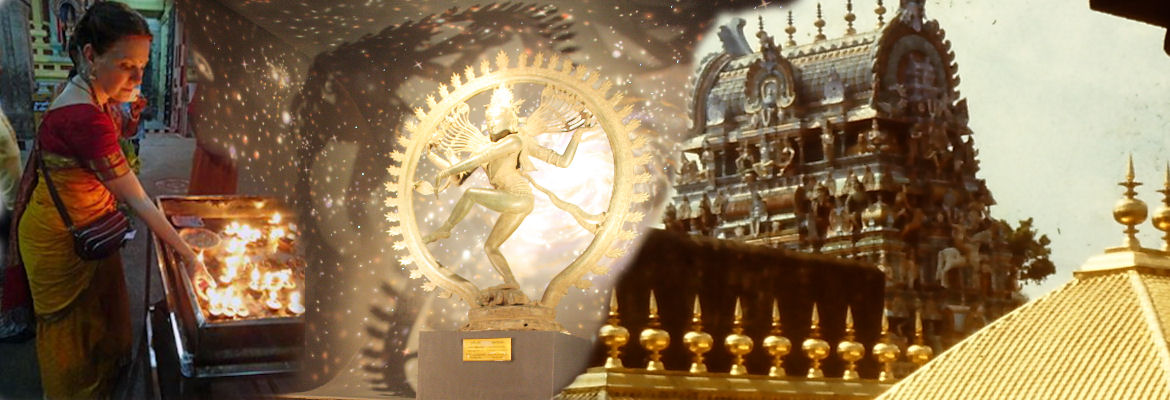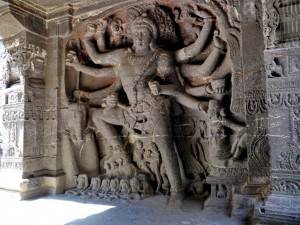
As always it makes me sad to note a sacred place has lost its living tradition. And has even lost its history. Besides I am really a bit surprised that with some 200 years of studies behind us there are still so many gaps and confusions surrounding the Kailasha temple in Ellora.
One such is the story expressed by one of the great reliefs on the walls of the shrine. (See the illustration) Shiva with ten arms and in a dynamic pose is accompanied by Devi Parvati who sits next to him. Lovingly he touches her cheek.
From what I could gather the figure in the relief is variously described as Bhairava or Andhakasuramardana. Both are incorrect. This relief actually depicts Shiva as Gajantaka, the Destroyer of the Elephant Demon. I will show why I make this identification.
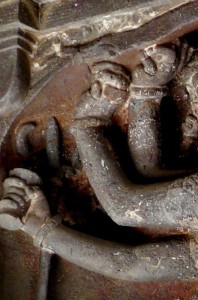
This relief is found on the ground floor (base) on the East facing wall of what is called the Nandi Shrine within the complex. It shows a ten armed figure in a dynamic pose with his right leg placed on top of the heads of several diminutive figures. It is surrounded with a host of other, smaller figures. First of all Shiva’s consort Parvati is sitting on his proper left, body turned away but face turned to him. He is touching her face with one of his hands. Further I see what are probably the Sapta Matrika below his right foot, possibly Bhringi on his (proper) left. Also two ganas next to his head, and an elephant head on his right. A dancing skeleton between his legs. He wears a mala of human heads.
In his hands several attributes are easily identifiable. Trisula on the right hand (second from below); Damaru next from below. On the left side he uses one hand to touch Parvati; one is holding the skullcap begging bowl. The others are not obviously identifyable from the photos I have at my disposal.
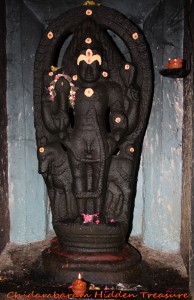
Bhairava is one of the Ugra or Raudra, Furious and Destructive forms of Shiva. Destruction in this connection is always the destruction of Evil in the form of Demons, negative cosmic forces. His mythology is connected to the decapitation of one of the five heads of Brahma, result of his ego and arrogance. Brahma was therefore four headed from that moment on. Bhairava is usually depicted with his vahana, the dog.
Andhaka was an Asura born from the mingling of sweat when Parvati in a playful mood covered Shiva’s eyes. The universe went dark and a child was born that was horrible looking and blind. He was given to the Asura Hiranyakasha as a son. He grew up, became very powerful, performed tapas for Brahma and became even more powerful. Then he somehow desired Parvati for a wife. A great battle was fought. Eventually Shiva pierced Andhaka with his trident. Andhaka realised his error and became Shiva’s main gana or follower.
In this relief in the Kailashanatha Shiva’s trident is very obviously present. But there is no sign of anyone being pierced on it. The Sapta Matrika sitting at his feet is an element which is mentioned in some of the versions of the myth. They are created to drink Andhaka’s blood, as every drop turns into new versions of him. Actually there is no sign of Andhaka in this relief. Many of the smaller figures are ganas, for instance the three figures under Shiva’s right foot. The other figures are also too small to be identified as Shiva’s demon opponent. And there is no fighting going on with any of them.
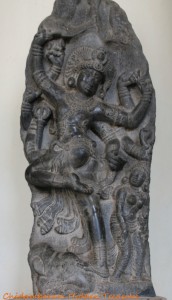
And then there is the elephant head on the proper left of Shiva. At first I thought this would be Ganesha, but there is no human body going with the head. And then I realised what we are looking at here. Because in the upper edge of the relief, just above the (proper) right hand second from above there is what may look like a damage or irregularity. But it is actually the elephant’s tail. For who is familiar with Gajasamharamurti or Gajantaka it will be obvious now. It also immediately clarifies the presence of Parvati and Shiva’s touching her face. This is a theme often found in depictions of Gajantaka Murti.
The story of how Shiva conquered the Elephant Demon and wore his skin as his upper cloth is found in many puranas. There is also in Tamil Nadu in Thiruvazhavoor a temple specially dedicated to this form of Shiva. It has one of the most beautiful bronze murtis imaginable. The sthala purana tells here how when Shiva as Bhikshatana challenged the rishis is the Daruvana they performed a magical yajña or fire sacrifice and from it conjured all kinds of creatures that attacked Shiva. Starting with a tiger, he tore its skin and wore it around his hips; a snake, a damaru, a dwarf, until finally they send an elephant demon against him. Now also he tore its skin and wore it, and started his Ananda Tandava, the Dance of Bliss. Later Shiva performed his Cosmic Dance in Chidambaram, and stayed to bless humanity.
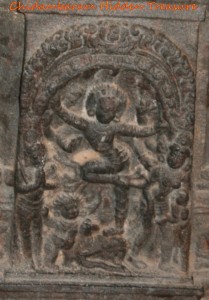
The purana of Varanasi tells how a demon in the form of an elephant became proud and arrogant after receiving a boon from Shiva. He started terrorising Brahmins and others. Shiva came and defeated him, tearing off his skin and wearing it.
There are other versions of this myth in other puranas.
The skin of the elephant being dull and grey represents darkness and dullness. As Shiva rips off the skin, beneath it appears the pure ivory white bone, the essence and the clarity of vision. That is the meaning of this purana.
Typical for the depiction of this Tandava of Shiva is the presence of a sometimes frightened Parvati holding a baby Murugan, where Shiva lovingly touches her chin, as to say, fear not, my beloved wife. In this panel the baby Murugan or Skanda seems to be missing.
Now we know what is the story behind this relief. Now we have to think why it was represented here, in this position within the sculptural plan of the Kailashanatha in Ellora.
As far as I could establish only one other person, a Dr.B.R.Satyanarayana, made the same identification on his photo page on Flickr.
